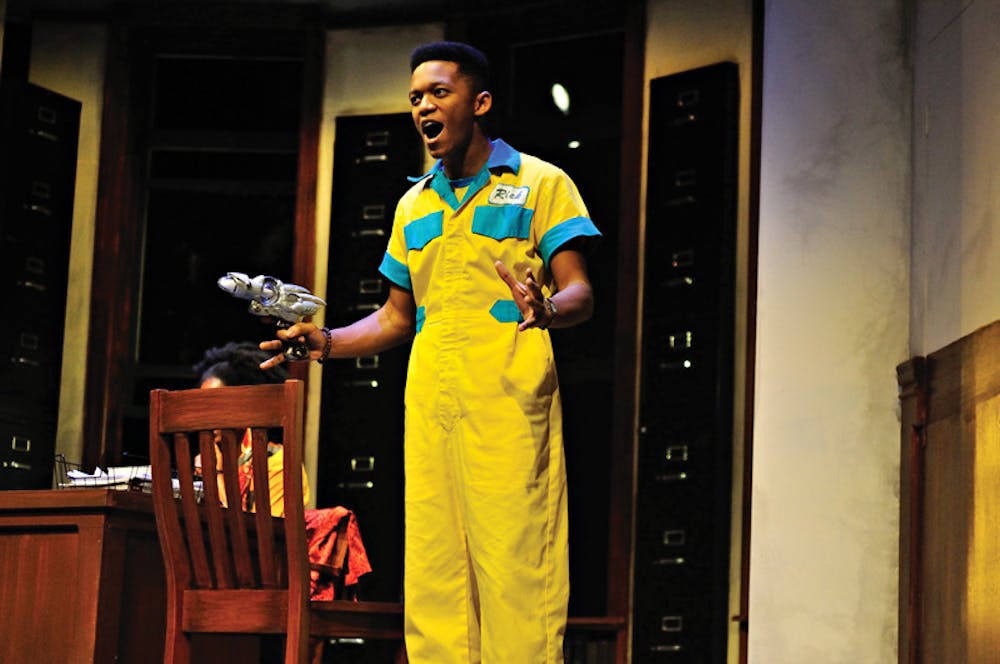The arts have never been a stranger to the vilification of greed, but the recent combination of economic recession, Occupy movements and increased populism have brought a resurgent relevance to the story of the systematic underdog. This dynamic manifests in recent releases like “The Dark Knight Rises,” “The Purge” and “The Wolf of Wall Street,” which demonstrate none-too-subtle derision toward current inequalities.
“Hype Hero” — ahead of its time in that it was originally written by Dominic Taylor MFA’95 in 1997 — brings to the stage the same sort of over-the-top satire at which the aforementioned blockbusters excelled in, eliciting laughs at the outrageous until a sense of reality simply elicits outrage. The clueless mayor of “Hero” might as well be Jonah Hill eating a goldfish, and its incompetent detectives engage in a variation on a motif from “The Purge” in which the rich kill the poor for sport — that is to say, heavy-handedness often wins out.
Yet at its best, “Hero” transcends the big-screen spectacle that is extreme corporatism and uses the stage to provide an intimate look into the struggles of a working-class black American who is reminiscent of Walter in Lorraine Hansberry’s “A Raisin in the Sun.”
Set in a future complete with a variation on a ray gun, “Hype Hero” offers a world in which debtors — those on welfare — are given a number and raffled off in a lottery to major corporations such as “Risney” and “Macrosoft” to work for the rest of their lives, wearing bright yellow jumpsuits as identifiers. Those in good standing with society hold corporate jobs, but are forced to flash an identification badge wherever they go to prove they are not associated with the debtors’ “patch program,” as the lottery is known. And celebrities, the richest of the rich, wander about as they please, influencing the public through media coverage, product placement and general speechifying.
The story centers on a showdown between Rick, a Macrosoft “employee,” and William Moore, architect of the patch system, Rhodes Scholar, chef, fraternity member and domain owner of bmore.com.
Rick begins the morning by traveling to the mayor’s office in hopes of asking her a question that she has apparently ignored via mail and telephone. But the government staff, realizing Rick is late to work, force him to leave the office without a response. Almost immediately after, William Moore swaggers in to a rock beat, wearing a shimmering black and red suit that is just a set of horns away from evoking the devil incarnate. He flirts his way through the office, falling for the secretary, Sarah, based partially on the fact that she doesn’t know who he is — she “sees” him.
Emmett Rahn-Oakes ’18 steals the show as Moore, suavely convincing every character he meets — as well as the audience — that he deserves to be the most popular man around. His flirtation with Sarah makes for the some of the show’s best conversations, as they dance around the topic of truth and lies with such charm and unpredictability that it crosses one’s mind that he is Satan coming to bargain for her soul. It helps that he has an equal sparring partner — Jordan DeLoach ’15 portrays Sarah with the perfect combination of world-weariness and gritty determination. It is one of the play’s perverse pleasures to watch as Moore and Sarah lose their fire as obstacles spring in their way. Moore transforms from the epitome of power to a child banished to sit in the corner of the room.
The cause of this transformation marks the strongest scene in “Hype Hero.” Rick, driven by an existential need for the truth, returns to the office to demand his answer by force, taking Sarah and Moore captive in the process. Keston McMillan ’17, who plays Rick, delivers by far the most impactful dialogue of the play, sharply dissecting what it means to be an equal in society. McMillan sustains audience rapture throughout the entire monologue, which evokes the desperation of omnipresent oppression, every look betraying his suspicion of those around him and every burst of anger dynamically emphasized — even as parts of the speech slip into heavy-handed rhetoric about the need for public schools and the dollar value of a human life.
That rhetoric is the rightful core of “Hype Hero” and succeeds in drawing compassion, but it is most successful when hidden. The beginning of the second act comprises the dullest part of the show, as two detectives — added for comic relief in a show where satire ought to dominate comedy — come into successive encounters with the stereotypical citizens who inhabit this cruel metropolis. For example, a businessman whose company sells treadmills declares that the reason for a health warning on the machines is not to save lives but to save litigation money, and a reporter drops in on City Hall to announce that, given the choice between no story and death, the media would prefer a death.
The confrontations are mildly humorous and well-delivered by the actors, but the satire is so obvious as to cross the line into an attempt at truth.
The back-and-forth between subtlety and blunt force can be jarring, but “Hype Hero” validates one of its own ideas — one lie in a story doesn’t contaminate it. Rather, it emphasizes the truth contained throughout the rest.

ADVERTISEMENT




